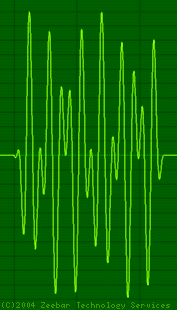 | ||||||||||||
|
Contents
| ||||||||||||
| ||||||||||||
|
| ||||||||||||||||||||||||||||||||||||
DTMF TonesThe sounds used for touch tone dialing are refered to as DTMF (Dual Tone Multiple Frequencies) tones. Each number (as well as the "#" and "*") is represented by a pair of tones. For instance, the number "1" is represented by the frequencies 1209 Hz and 697 Hz. The following table shows the DTFM frequencies and the corresponding keys.
For example, in order to generate the DTMF tone for "1", you mix a pure 697 Hz signal with a pure 1209 Hz signal, like so:
DTMF "Touch" Tones are defined in CCITT Volume VI: General Recommendations on Telephone Switching and Signalling Recommendation Q.23: Technical Features of Push-Button Telephone Sets.". This document and its related standard documents will tell you more than you would ever want to know about DTMF tones. What about the A, B, C, and D keys?The standard defines the DTMF tones for 16 keys, but telephones only use 12 of these 16 keys. The remaining 4 tones are sometimes used within the telephone networks, but unless you are a telecommunication geek working for a telephone company or the military, you will probably never get to hear one of these tones, but, if you are anxious to know what these tones sound like, you can use our online DTMF tone generator to create and download computer audio files containing DTMF tones from the elusive 4th column. Just enter uppercase A, B, C, or D instead of a number and you will get those tones. | ||||||||||||||||||||||||||||||||||||


